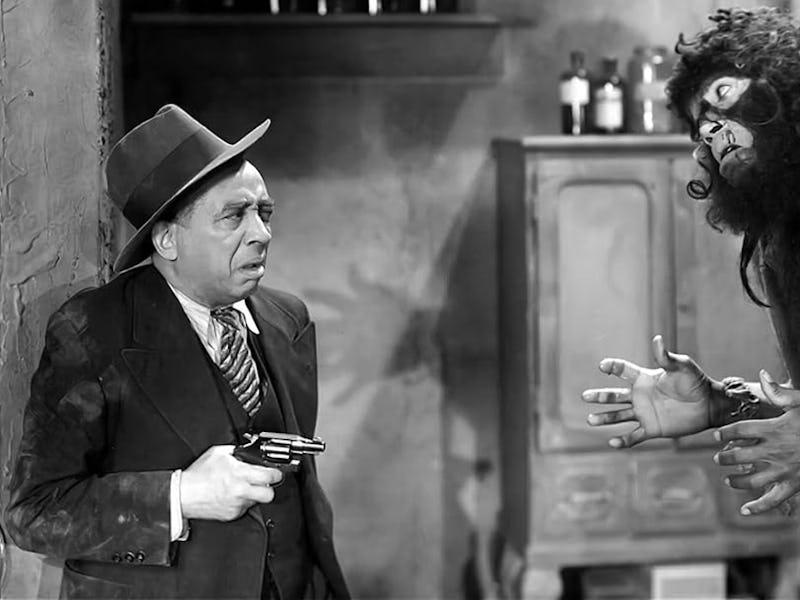Decades Ago, A Forgotten Monster Movie Changed Black Horror Forever
There’s a first time for everything.

When discussing the history of Black horror movies, the key milestones are typically Duane Jones’ tragic hero in Night of the Living Dead, the scarier side of the Blaxploitation movement, and Tony Todd’s supernatural villain in Candyman. Much less well-known is a ground-breaking 1940 monster movie that not only boasted an all-Black cast but, in a revolutionary move for the time, portrayed them in a positive light.
Adapted by future Amos ‘n' Andy Show star Spencer Williams from his own short story House of Horror, Son of Ingagi arrived when most actors of color were still resigned to playing Mammy and Uncle Tom stereotypes. This was the year after Gone with the Wind, one of the most egregious examples of early Hollywood racism. Blackface, as proven by the likes of serial offender Al Jolson, was still very much the norm.
Son of Ingagi (not to be confused with Ingagi, the unrelated and far more problematic 1930 exploitation flick), however, swerved all the usual caricatures. It takes place in a middle-class community populated by professionals, most of whom are portrayed as successful, sympathetic, and smart. It never touches on the issue of race. It may have only played in segregated theaters, but this is essentially a straightforward genre pic, albeit one that takes a while to veer into its genre.
In fact, the first third of its slim 70-minute run time plays out like a feel-good marital tale. Central couple Robert (Alfred Grant) and Eleanor (Daisy Bufford) Lindsay return home from their nuptials to be gatecrashed by a party that includes real-life group vocal The Four Toppers. Touched by their invitation, eccentric next-door neighbor Dr. Jackson (Laura Bowman) is busy rearranging her will for what turns out to be a hugely generous wedding gift (even if it does inadvertently frame them for murder).
It’s only when the latter’s dastardly brother pays a visit that things take a frightful turn. Convinced the doctor has brought back a stash of gold from her lengthy sojourn to Africa, Zeno (Arthur Ray) has no qualms about using threats to get what he wants (“If you try any of your black magic on me, I might forget that you're my sister”). He’s soon silenced, though, and left so scared by a missing link monster she’s been hiding in her basement he willingly jumps out of a window.
Our monster, which appears to have raided the dress-up box.
N’Gina (Zack Williams) initially appears to be a harmless, pitiful beast. In one of the many narrative gaps audiences are required to fill in themselves, it’s never made clear exactly how or why Jackson acquired him. Tragically, after mistakenly drinking a prototype potion that’s somehow intended to save the world, his adverse reaction turns N’Gina into a lean, mean murder machine.
Sadly, for both the character and the film itself, Jackson is his first target. Bowman — who rose to fame as a vaudeville performer with husband Pete Hampton — steals every scene as the cantankerous yet strangely likable spinster. In a role that Black actors, let alone Black women, were rarely afforded, Bowman plays the “mad scientist” while also delivering several sassy putdowns (“I don’t like detectives, especially fat ones,” she quips). Yet there’s a clear vulnerability behind the sharp tongue and weird science. The scene where she asks Eleanor why she was invited to her wedding, before opening up about her lost love, is genuinely touching.
Still, Jackson’s shocking demise sure makes an impact, with director Richard C. Kahn (a B-movie regular and the film’s sole white talent) cleverly cutting to a spilled ink bottle to signify the bloodshed. Things get even more gruesome (off-screen) when the Lindsays move into the home they’ve been bequeathed, and N’Gina breaks the neck, ribs, and arms of executor Bradshaw (Earl J. Morris). In an unintentionally funny moment, Detective Nelson (writer Jackson pulling double duty) first theorizes it was suicide.
A colorized version of the mad scientist and her monster.
Not all the humor is accidental. The film often leans into pure farce, from the overlong sketch where N’Gina twice steals a sandwich behind the bewildered Nelson’s back, to the home invasion scene where Eleanor mistakenly hits her husband over the head in the dead of night. It’s not exactly sophisticated, but considering the man-beast is blatantly Williams with a fur-clad ski mask over his head, such slapstick could never be accused of betraying the tone.
Yes, while Son of Ingagi might be the first true Black horror, it’s not the first horrifying Black horror. Even during the action-packed denouement, when N’Gina murders the trespassing Zeno, carries Eleanor to his lair, and accidentally starts the house fire that leads to his own demise, the vibe is more mild peril than genuine terror. The lack of a score — long sections of the film are played out in near-silence — doesn’t exactly help create an atmosphere, either.
Nevertheless, Son of Ingagi’s cultural importance shouldn’t be underestimated. The Black horror movement is finally enjoying a long-overdue renaissance, but whether its fans and creatives know it or not, its roots lie in this ahead-of-its-time curiosity.